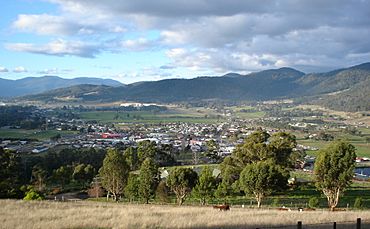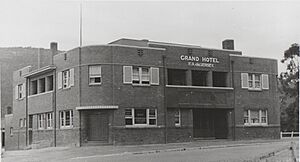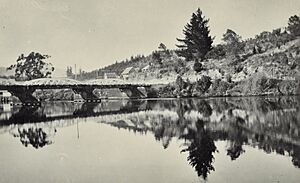Huonville facts for kids
Quick facts for kids HuonvilleTasmania |
|||||||||
|---|---|---|---|---|---|---|---|---|---|

Huonville township from Scenic Hill
|
|||||||||
| Population | 3,002 (2021 census) | ||||||||
| Established | 1891 | ||||||||
| Postcode(s) | 7109 | ||||||||
| Time zone | AEST (UTC+10) | ||||||||
| • Summer (DST) | AEDT (UTC+11) | ||||||||
| Location | |||||||||
| LGA(s) | Huon Valley Council | ||||||||
| State electorate(s) | Franklin | ||||||||
| Federal Division(s) | Franklin | ||||||||
|
|||||||||
Huonville is a town in Tasmania, Australia. It sits on the banks of the Huon River in the beautiful Huon Valley. This town is the main centre for the Huon Valley Council. It is also the biggest town in the whole Huon Valley region.
Huonville is about 38 kilometres south of Hobart, Tasmania's capital city. It is often seen as the starting point for exploring Tasmania’s wild areas. These include the amazing Southwest National Park.
Historically, Huonville was very important for growing apples. The Huon Valley was even called the "Golden Valley" because of its many Golden Delicious apples. While apple growing is not as big now, Huonville is still an important farming area. It is also known for aquaculture, which means farming seafood like salmon. Tourism is growing too, with visitors enjoying the pretty scenery and outdoor activities. These activities include hiking, kayaking, and fishing.
In 2021, Huonville had a population of 3,002 people. The town is close to the Huon Highway. This highway connects Huonville to nearby towns and Hobart. This makes it a key place for transport and trade in the region. Huonville has faced challenges like floods and bushfires in recent years. But it continues to grow as a place for eco-tourism and farming that protects the environment. It keeps its country feel while adapting to new times.
Contents
History of Huonville
Before Europeans arrived, the area around Huonville was home to the Mellukerdee people. They were one of the First Nations groups in southern Tasmania. The Mellukerdee people lived along the Huon River. They used its resources for fishing and hunting. Their connection to the land was a big part of their daily life.
European explorers first came to the Huon River in 1792. Admiral Bruni d'Entrecasteaux led this trip. He named the river after his second-in-command, Captain Jean-Michel Huon de Kermadec. European settlers started farms in the valley in the 1840s. William and Thomas Walton were among the first.
Huonville started as a small settlement. It grew because of a key bridge over the Huon River. This bridge made it a good spot for transport and trade. Even though another town, Ranelagh, was first planned as the main centre, Huonville became the busy heart of the Huon Valley. It was officially declared a town in 1891.
Apple Growing in the Valley
By the late 1800s, growing apples became the main farming activity in the Huon Valley. The rich soil and mild weather were perfect for apples. Huonville was central to processing and sending out the fruit. For much of the 1900s, the valley was known as the "Apple Bowl of Tasmania." Apples were a major export for Tasmania.
At its busiest, Huonville and nearby areas grew 83% of Tasmania’s apples. The apple industry was so famous that Tasmania was nicknamed "The Apple Isle." Apples were sent all over the world, especially to the United Kingdom.
However, the apple industry started to slow down later in the 1900s. This was due to changes in world trade and competition. Even so, apple orchards are still important to the Huon Valley. Huonville celebrates its apple history every year. The town hosts the Huon Valley Mid-Winter Festival. This festival includes a special ceremony to bless the apple trees. Huonville has also become a centre for making special ciders.
The town has also faced natural challenges. There were big floods in 2016 and large bushfires in 2019. These events show how the region can be affected by changes in weather.
Economy
Huonville is still a key farming centre in the Huon Valley. Apple growing is important, along with other fruits like cherries and berries. But seafood farming, especially salmon, has become a very big industry. Huon Aquaculture, a large salmon producer, has farms in the nearby Huon River.
The town is also becoming a popular place for tourists. Visitors come for unique food and drinks. They also enjoy outdoor activities like hiking, kayaking, and fishing. Huonville is on the edge of Tasmania's wild areas. This makes it a great stop for people exploring the national parks.
Population and People
| Historical population | ||
|---|---|---|
| Year | Pop. | ±% |
| 2001 | 1,598 | — |
| 2006 | 1,705 | +6.7% |
| 2011 | 1,741 | +2.1% |
| 2016 | 2,714 | +55.9% |
| 2021 | 3,002 | +10.6% |
| Source: Australian Bureau of Statistics census data. | ||
Huonville's population shows its role as a country hub for farming areas. The town's population has grown steadily. In 2021, it reached 3,002 people. If you include the surrounding rural areas, the total population is 4,579 residents.
Most people in Huonville have Australian (61.3%) or English (24.7%) backgrounds. About 7.1% of the population identify as Aboriginal Australians or Torres Strait Islander. This number is higher than the national average. This is common in many regional Tasmanian towns.
Nearly half (46.8%) of the people said they had no religion in 2021. Anglicanism was the most common religion (18.4%). The average age in Huonville was 45 years. This is older than the national average of 38. This shows that many rural Tasmanian towns have an older population.
In 2021, the average weekly household income in Huonville was $1,135. This is lower than the national average of $1,746. This reflects its country economy, which relies on farming and fishing. These jobs often pay less than those in big cities. The town's unemployment rate was 7.2%, which was slightly higher than the national average.
More people own their homes in Huonville compared to bigger cities. Property prices are more affordable. This attracts families, retirees, and those who want a country lifestyle. Huonville is only 38 km from Hobart. This makes it a good choice for people who work in the city but want cheaper living costs.
Climate
Huonville has a mild, oceanic climate. This means it has cool, wet winters and mild, dry summers. The average highest temperature is around 22.4°C in February. It drops to about 11.8°C in July. The average lowest temperatures range from 9.4°C in summer to 2.0°C in winter.
Huonville gets about 744.7 mm of rain each year. The rain is spread fairly evenly throughout the year. The hottest temperature ever recorded was 40.4°C in January 2009. The coldest was -7.5°C in June 1972.
| Climate data for Huonville (42º58'48"S, 147º04'48"E, 63 m AMSL) (1952-2010 normals and extremes) | |||||||||||||
|---|---|---|---|---|---|---|---|---|---|---|---|---|---|
| Month | Jan | Feb | Mar | Apr | May | Jun | Jul | Aug | Sep | Oct | Nov | Dec | Year |
| Record high °C (°F) | 40.4 (104.7) |
39.7 (103.5) |
37.3 (99.1) |
31.7 (89.1) |
25.1 (77.2) |
21.0 (69.8) |
19.7 (67.5) |
23.6 (74.5) |
28.6 (83.5) |
32.2 (90.0) |
36.6 (97.9) |
37.2 (99.0) |
40.4 (104.7) |
| Mean daily maximum °C (°F) | 22.3 (72.1) |
22.4 (72.3) |
20.5 (68.9) |
17.6 (63.7) |
14.5 (58.1) |
12.1 (53.8) |
11.8 (53.2) |
13.0 (55.4) |
14.9 (58.8) |
16.9 (62.4) |
18.5 (65.3) |
20.3 (68.5) |
17.1 (62.7) |
| Mean daily minimum °C (°F) | 9.4 (48.9) |
9.4 (48.9) |
8.0 (46.4) |
6.2 (43.2) |
4.3 (39.7) |
2.4 (36.3) |
2.0 (35.6) |
2.7 (36.9) |
4.1 (39.4) |
5.7 (42.3) |
7.1 (44.8) |
8.6 (47.5) |
5.8 (42.5) |
| Record low °C (°F) | 0.3 (32.5) |
−0.6 (30.9) |
−1.7 (28.9) |
−3.4 (25.9) |
−5.5 (22.1) |
−7.5 (18.5) |
−5.6 (21.9) |
−4.6 (23.7) |
−5.7 (21.7) |
−3.2 (26.2) |
−1.8 (28.8) |
−1.4 (29.5) |
−7.5 (18.5) |
| Average precipitation mm (inches) | 46.6 (1.83) |
47.1 (1.85) |
48.3 (1.90) |
60.7 (2.39) |
58.6 (2.31) |
61.4 (2.42) |
71.9 (2.83) |
78.0 (3.07) |
74.7 (2.94) |
69.1 (2.72) |
65.7 (2.59) |
62.4 (2.46) |
744.7 (29.32) |
| Average precipitation days (≥ 0.2 mm) | 10.3 | 9.0 | 10.8 | 12.8 | 14.3 | 14.4 | 16.3 | 16.2 | 16.1 | 16.0 | 14.5 | 12.7 | 163.4 |
| Average afternoon relative humidity (%) | 53 | 53 | 56 | 60 | 67 | 71 | 68 | 63 | 59 | 58 | 58 | 56 | 60 |
| Average dew point °C (°F) | 9.6 (49.3) |
10.2 (50.4) |
9.2 (48.6) |
7.9 (46.2) |
6.8 (44.2) |
5.3 (41.5) |
4.7 (40.5) |
4.5 (40.1) |
5.1 (41.2) |
6.4 (43.5) |
7.9 (46.2) |
8.8 (47.8) |
7.2 (45.0) |
| Mean monthly sunshine hours | 238.7 | 209.1 | 179.8 | 144.0 | 114.7 | 93.0 | 111.6 | 139.5 | 159.0 | 198.4 | 204.0 | 220.1 | 2,011.9 |
| Percent possible sunshine | 52 | 54 | 47 | 44 | 38 | 34 | 38 | 43 | 45 | 48 | 47 | 46 | 45 |
| Source: Bureau of Meteorology (1952-2010 normals and extremes) | |||||||||||||
Getting to Huonville
Huonville is 38 km south of Hobart. You mainly get there by using the Huon Highway. This highway goes through the town. It connects Huonville to Hobart in the north. It also links to southern towns like Geeveston, Dover, and Southport.
The Huon Highway offers beautiful views as it winds through the Huon Valley. It crosses the Huon River over a bridge in Huonville. This bridge is very important for connecting the town to the western side of the river. Other local roads branch off the highway. These lead to smaller places like Cygnet, Franklin, and Ranelagh.
Public transport is available, but it is limited. Private bus companies run regular routes between Huonville and Hobart. These buses help people who work or study in Hobart.
Cycling is becoming more popular in the Huon Valley. The scenic routes attract both locals and visitors. However, there are not many special cycling paths. Cyclists often share the roads with cars.
Huonville is also a starting point for exploring Tasmania's wilder southern areas. This includes the Southwest National Park. This makes it a key stop for tourists. The town's location on the Huon River was historically important. Farm products, especially apples, were once floated down the river to ports in Hobart.
Famous People
- Amy Sherwin – a soprano singer known as "The Tasmanian Nightingale"
- Geoffrey Proud – an artist who won the 1990 Archibald Prize and the 1975 Sulman Prize




